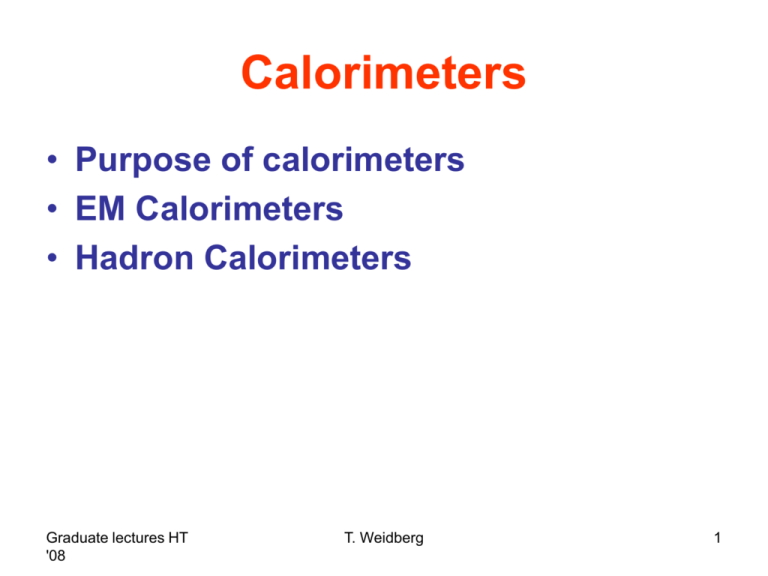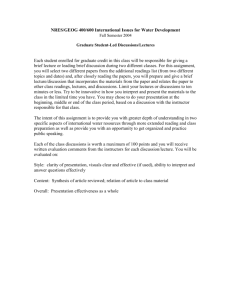Calorimeters
advertisement

Calorimeters • Purpose of calorimeters • EM Calorimeters • Hadron Calorimeters Graduate lectures HT '08 T. Weidberg 1 EM Calorimeters • Measure energy (direction) of electrons and photons. • Identify electrons and photons. • Reconstruct masses eg – Z e+ e p0 g g – H gg • Resolution important: • Improve S/N • Improve precision of mass measurement. Graduate lectures HT '08 T. Weidberg 2 EM Calorimeters • Electron and photon interactions in matter • Resolution • Detection techniques • Sampling calorimeters vs all active • Examples Graduate lectures HT '08 T. Weidberg 3 12.2 Charged particles in matter (Ionisation and the Bethe-Bloch Formula, variation with bg) m+ can capture eEmc = critical energy defined via: dE/dxion.=dE/dxBrem. Graduate lectures HT '08 T. Weidberg 4 Charged particles in matter (Bremsstrahlung = Brakeing Radiation) • Due to acceleration of incident charged particle in nuclear Coulomb field g • Radiative correction to Rutherford Scattering. ee• Continuum part of x-ray emission spectra. Ze • Emission often confined to incident electrons because – radiation ~ (acceleration)2 ~ mass-2. • Lorentz transformation of dipole radiation from incident particle centre-of-mass to laboratory gives narrow (not sharp) cone of blue-shifted radiation centred around cone angle of =1/g. • Radiation spectrum very uniform in energy. • Photon energy limits: – low energy (large impact parameter) limited through shielding of nuclear charge by atomic electrons. – highlectures energy incident particle energy. Graduate HT limited by maximum T. Weidberg '08 5 12.2 Charged particles in matter (Bremsstrahlung EM-showers, Radiation length) • dT/dx|Brem~T (see Williams p.247) dominates over dT/dx|ionise ~ln(T) at high T. • For electrons Bremsstrahlung dominates in nearly all materials above few 10 MeV. Ecrit(e-) ≈ 600 MeV/Z • If dT/dx|Brem~T dT/dx|Brem=T0exp(-x/X0) • Radiation Length X0 of a medium is defined as: – distance over which electron energy reduced to 1/e. – X0~Z2 approximately. • Bremsstrahlung photon can undergo pair production (see later) and start an em-shower (or cascade) • Length scale of pair production and multiple scattering are determined by X0 because they also depend on nuclear coulomb scattering. The development of em-showers, whether started by primary e or g is measured in X0. Graduate lectures HT '08 T. Weidberg 6 Very Naïve EM Shower Model • Simple shower model assumes: – E0 >> Ecrit – only single Brem-g or pair production per X0 • The model predicts: – after 1 X0, ½ of E0 lost by primary via Bremsstrahlung – after next X0 both primary and photon loose ½ E again – until E of generation drops below Ecrit – At this stage remaining Energy lost via ionisation (for e+-) or compton scattering, photoeffect (for g) etc. – Abrupt end of shower happens at t=tmax = ln(E0/Ecrit)/ln2 Graduate lectures HT T. Weidberg – Indeed observe logarithmic depth dependence '08 7 13.1 Photons in matter • • Rayleigh scattering – Coherent, elastic scattering of the entire atom (the blue sky) g + atom g + atom – dominant at lg>size of atoms Compton scattering – – – • • (Overview) Incoherent scattering of electron from atom g + e-bound g + e-free possible at all Eg > min(Ebind) to properly call it Compton requires Eg>>Ebind(e-) to approximate free e- Photoelectric effect – absorption of photon and ejection of single atomic electron g + atom g + e-free + ion – possible for Eg < max(Ebind) + dE(Eatomic-recoil, line width) (just above k-edge) Pair production – absorption of g in atom and emission of e+e- pair – Two varieties: g + nucleus e+ + e- + nucleus (more momentum transfer to nucleusdominates) g + Z atomic electrons e+ + e- + Z atomic electrons • both summarised via: g + g(virtual) e+ + e– Needs Eg>2mec2 – Nucleus has to recoils to conserve momentum coupling to nucleus needed strongly Z-dependent crossection Graduate lectures HT '08 T. Weidberg 8 13.1 Photons in matter (Note on Pair Production) • Compare pair production with Bremsstrahlung Typical Lenth = Radiation Length X0 Pair production Bremsstrahlung g g e- Typical Lenth = Pair Production Length L0 ee-* e-* eZe e- Ze • Very similar Feynman Diagram • Just two arms swapped L0=9/7 X0 Graduate lectures HT '08 T. Weidberg 9 13.1 Photons in matter (Crossections) Lead Carbon • • • R Rayleigh PE Photoeffect C Compton Graduate lectures HT '08 • • • PP Pair Production PPE Pair Production on atomic electrons PN Giant Photo-Nuclear dipole T. Weidberg resonance 10 Transverse Shower Size • Moliere radius = 21 MeV X0/Ec Electrons Graduate lectures HT '08 Photons T. Weidberg 11 Sampling vs All Active • Sampling: sandwich of passive and active material. eg Pb/Scintillator. • All active: eg Lead Glass. • Pros/cons – Resolution – Compactness costs. Graduate lectures HT '08 T. Weidberg 12 Detection Techniques • • • • • Scintillators Ionisation chambers Cherenkov radiation (Wire chambers) (Silicon) Graduate lectures HT '08 T. Weidberg 13 Organic Scintillators (1) • Organic molecules (eg Naphtalene) in plastic (eg polysterene). • excitation non-radiating deexcitation to first excited state scintillating transition to one of many vibrational sub-states of the ground state. Graduate lectures HT '08 T. Weidberg 14 Organic Scintillators (2) • gives fast scintillation light, deexcitation time O(10-8 s) • Problem is short attenuation length. – Use secondary fluorescent material to shift l to longer wavelength (more transparent). – Light guides to transport light to PMT or – Wavelength shifter plates at sides of calorimeter cell. Shift blue green (K27) longer attenuation length. Graduate lectures HT '08 T. Weidberg 15 Inorganic Scintillators (1) • eg NaI activated (doped) with Thallium, semiconductor, high density: r(NaI=3.6), high stopping power • Dopant atom creates energy level (luminescence centre) in band-gap • Excited electron in conduction band can fall into luminescence level (non radiative, phonon emission) • From luminescence level falls back into valence band under photon emission • this photon can only be re-absorbed by another dopant atom crystal remains transparent Graduate lectures HT '08 T. Weidberg 16 Inorganic Scintillators (2) • High density of inorganic crystals good for totally absorbing calorimetry even at very high particle energies (many 100 GeV) • de-excitation time O(10-6 s) slower then organic scintillators. • More photons/MeV Better resolution. • PbWO4. fewer photons/MeV but faster and rad-hard (CMS ECAL). Graduate lectures HT '08 T. Weidberg 17 Detectors (1) • Photomultiplier: – primary electrons liberated by photon from photo-cathode (low work function, high photo-effect crossection, metal, hconversion≈¼ ) – visible photons have sufficiently large photo-effect cross-section – acceleration of electron in electric field 100 – 200 eV per stage – create secondary electrons upon impact onto dynode surface (low work function metal) multiplication factor 3 to 5 – 6 to 14 such stages give total gain of 104 to 107 – fast amplification times (few ns) good for triggers or veto’s – signal on last dynode proportional to #photons impacting PMT Graduate lectures HT '08 T. Weidberg 18 Detectors (2) • APD (Avalanche Photo Diode) – solid state alternative to PMT – strongly forward biased diode gives “limited” avalanche when hit by photon Graduate lectures HT '08 T. Weidberg 19 13.2 Detectors • Ionisation Chambers – Used for single particle and flux measurements – Can be used to measure particle energy up to few MeV with accuracy of 0.5% (mediocre) – Electrons more mobile then ions medium fast electron collection pulse O(ms) – Slow recovery from ion drift Graduate lectures HT '08 T. Weidberg 20 Resolution • Sampling fluctuations for sandwich calorimeters. • Statistical fluctuations eg number of photo-electrons or number of e-ion pairs. • Electronic noise. • Others – Non-uniform response – Calibration precision – Dead material (cracks). – Material upstream of the calorimeter. – Lateral and longitudinal shower leakage • Parameterise resolution as – a Statistical – b noise – c constant Graduate lectures HT '08 T. Weidberg E a b c E E E 21 Classical Pb/Scintillator Graduate lectures HT '08 T. Weidberg 22 Lead Glass • All active • Pb Glass Graduate lectures HT '08 T. Weidberg 23 BGO • Higher resolution (E) E ~ 1% ( E 1GeV ) Graduate lectures HT '08 T. Weidberg 24 Liqiuid Argon • Good resolution eg NA31. (E) E ~ 8% E Graduate lectures HT '08 T. Weidberg 25 Fast Liquid Argon • Problem is long drift time of electrons (holes even slower). • Trick to create fast signals is fast pulse shaping. – Throw away some of the signal and remaining signal is fast (bipolar pulse shaping). – Can you maintain good resolution and have high speed (LHC)? Graduate lectures HT '08 T. Weidberg 26 Accordion Structure Lead plates Cu/kapton electrodes for HV and signal Liquid Argon in gaps. Low C and low L cf cables in conventional LAr calorimeter. Graduate lectures HT '08 T. Weidberg 27 Bipolar Pulse Shaping Graduate lectures HT '08 T. Weidberg 28 Graduate lectures HT '08 T. Weidberg 29 ATLAS Liquid Argon • Resolution – Stochastic term ~ 1/E1/2. – Noise ~ 1/E – Constant (nonuniformity over cell, calibration errors). Graduate lectures HT '08 T. Weidberg 30 Calibration • Electronics calibration – ADC counts to charge in pC. How? • For scintillators – Correct for gain in PMT or photodiode. How? – Correct for emission and absorption in scintillator and light guides. How ? • Absolute energy scale. – Need to convert charge seen pC E (GeV). How? Graduate lectures HT '08 T. Weidberg 31 Hadron Calorimeters • • • • Why you need hadron calorimeters. The resolution problem. e/pi ratio and compensation. Some examples of hadron calorimeters. Graduate lectures HT '08 T. Weidberg 32 Why Hadron Calorimeters • Measure energy/direction of jets – Reconstruct masses (eg tbW or h bbar) – Jet spectra: deviations from QCD quark compositeness) • Measure missing Et (discovery of Ws, SUSY etc). • Electron identification (Had/EM) • Muon identification (MIPs in calorimeter). • Taus (narrow jets). Graduate lectures HT '08 T. Weidberg 33 Hadron Interactions • Hadron interactions on nuclei produce – More charged hadrons further hadronic interactions hadronic cascade. p0 gg EM shower – Nuclear excitation, spallation, fission. – Heavy nuclear fragments have short range tend to stop in absorber plates. – n can produce signals by elastic scattering of H atoms (eg in scintillator) • Scale set by lint (eg = 17 cm for Fe, cf X0=1.76 cm) next transparency Graduate lectures HT '08 T. Weidberg 34 Graduate lectures HT '08 T. Weidberg 35 Resolution for Hadron Calorimeters • e/pi ≠ 1 fluctuations in p0 fraction in shower will produce fluctuations in response (typically e/pi >1). • Energy resolution degraded and no longer scales as 1/E1/2 and response will tend be non-linear because p0 fraction changes with E. Graduate lectures HT '08 T. Weidberg 36 e/h Response vs Energy Graduate lectures HT '08 T. Weidberg 37 Resolution Plots (E)/E vs 1/E1/2. Fe/Scint (poor). ZEUS U/scint and SPACAL (good). Graduate lectures HT '08 T. Weidberg 38 Compensation (1) • Tune e/pi ~= 1 to get good hadronic resolution. • U/Scintillator (ZEUS) – Neutrons from fission of U238 elastic scatter off protons in scintillator large signals compensate for nuclear losses. – Trade off here is poorer EM resolution. Graduate lectures HT '08 T. Weidberg 39 Compensation (2) • Fe/Scintillator (SPACAL) – Neutrons from spallation in any heavy absorber can scatter of protons in scintillator large signals. – If the thickness of the absorber is increased greater fraction of EM energy is lost in the passive absorber. – tune ratio of passive/active layer thickness to achieve compensation. – Needs ratio 4/1 to achieve compensation. No use for classical calorimeter with scintillator plates (why). – SPACAL: scintillating fibres in Fe absorber. Graduate lectures HT '08 T. Weidberg 40 Scintillator Readout Graduate lectures HT '08 T. Weidberg 41 SPACAL 1 mm scintillating fibres in Fe Graduate lectures HT '08 T. Weidberg 42 Graduate lectures HT '08 T. Weidberg 43 Graduate lectures HT '08 T. Weidberg 44 Compensation (3) • Software weighting (eg H1) • EM component localized de-weight large local energies • Very simplified: E 'K EK (1 CEK ) ETOTAL E 'K k Graduate lectures HT '08 T. Weidberg 45 Fine grain Fe/Scintillator Calorimeter (WA1) • With weighting resolution improved. Graduate lectures HT '08 T. Weidberg (E) E 58% E 46 H1 Hadronic resolution with weighting Standard H1 weighting Improved (Cigdem Issever) Graduate lectures HT '08 T. Weidberg 47








